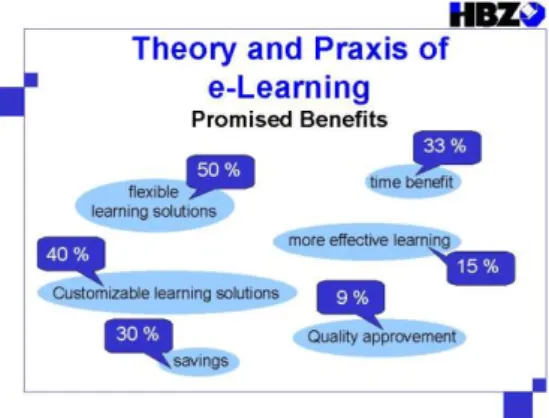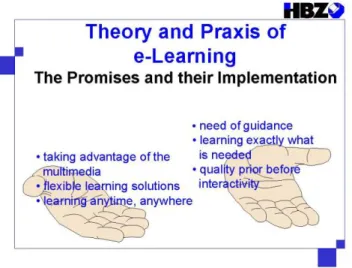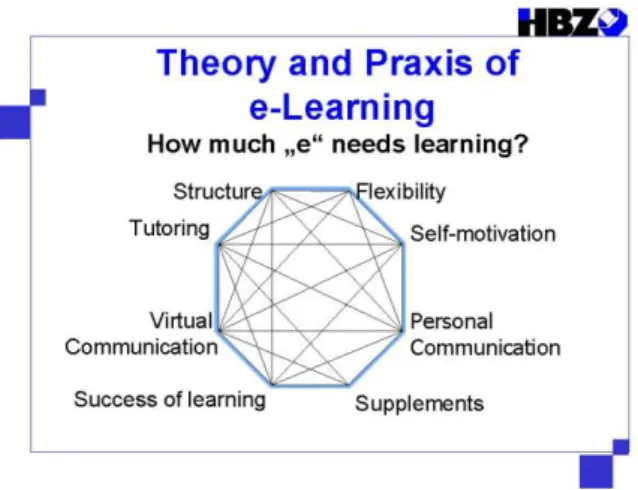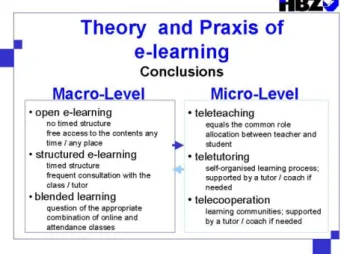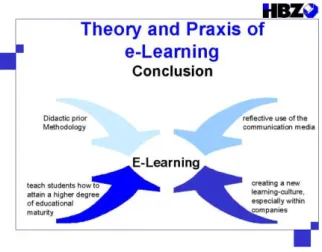Alexa Pieper
Handwerkskammer Bildungszentrum, Münster, Germany
alexa.pieper@hwk-muenster.de
THEORY AND PRAXIS OF E-LEARNING – A CRITICAL REVIEW
Az e-learning elméleti és gyakorlati kérdései – kritikai áttekintés
Recent surveys and press releases show that the euphoria towards e-learning of the past years has given way to plain disenchantment.
Now that provider, developers and users of e-learning solutions have gained first insight in the reality of this brave new world of teaching and learning it is obvious that we have just scratched the top of the iceberg if it comes to the capabilities of e- learning.
***
A Münsteri Iparkamara képzési programjaiban már több mint másfél éve szere- pelnek e-learning programok is. Eddigi tapasztalataink alapján azt a kérdést vizsgá- lom, hogy milyen mértékben váltotta be az e-learning azokat az ígéreteket, amelyek a rugalmas, tér- és időbeli korlátoktól mentes önirányításos tanulásra vonatkoztak.
Az már bizonyos, hogy a munkaerő-piaci képzéseket eddig ez az oktatási forma nem változtatta meg jelentős mértékben. Az e-learning inkább kiegészítő képzési forma- ként terjedt el. Az interneten keresztül történő web alapú tanulás lehetővé teszi a multimediális hatások széleskörű felhasználását. A többféle kódolású információ- prezentáció érdekesebbé teheti a tanulást, Hogy ez milyen mértékben realitás már ma, ezt a kérdést vizsgálom előadásomban.
Figure 1: Some figures
To begin with, e-learning has started with the most promising idea of providing low-budged education to everyone, everywhere and as much customised as possible.
Therefore the internet has been employed as the most prominent teaching aid, due to the fascination of its technical potentialities. And it does bare much potential, indeed – just are interactivity and gaudily animated pictures enough to get students in the picture?
So what’s about the enchantment of the new media, the new learning solutions?
What’s about the fun-factor of learning with the internet? What’s about it’s praised benefits?
Lets have a closer look! (Figure 1.)
E-learning makes learning more flexible! – jet, just 50 % of the users agree with that.
E-learning means a quality approvement of learning solutions – just that only 9
% feel this approvement already.
E-learning offers the possibility of customisable learning solutions – as 40 % of our users concede.
E-learning doesn’t only save time – which 33 % of our customers agree with – but money as well – as 30 % detected.
Last but not least, e-learning is said to make learning more effective – which only 15 % have endorsed so far.
Well, we have to admit these figures – being the results of recent surveys in Germany – don’t throw a very good light on the praxis of e-learning.
Furthermore as to the number of users we can enter on the credit side so far – not quite 1 % for the German crafts sector – it could be better as well!
Jet more than to resign it is about time for a cash check and to bring the first practical experiences to bear.
Therefore we first of all would have to clarify the questions to be ask:
What components do we have to consider if it comes to e-learning?
Which of the promised advantages have been self-fulfilling so far? And why?
Correspondingly, which haven’t been self-fulfilling and why not?
As to question No 1 – the components to be considered in e-learning – we can identify the following components:
Figure 3: Components to be considered
On the one hand we find the students who are using e-learning – or who we would like to use e-learning –; their learning back-ground – that is how they have experienced learning hitherto; as well as their expectations and needs towards edu- cation in general and e-learning in particular.
On the other hand we have those who are dealing with e-learning as providers, developers, teachers.
They, too, follow certain aims and attempts and to do so, they can go back to the whole bandwidth of multimedia-solutions. Which evidently causes the problem of decision making.
Another central questions occurs: How much “e” does learning need? – We will come back to this question later on.
To give an answer to Questions 2 and 3, which are related close to each other, it is most important to keep the above mentioned – well, lets say – fronting groups in mind.
Figure 4: The Promises and their Implementation
As to the promises of e-learning the questions whether they could be complied or not mainly is a question of how well the aims and attempts of the providers have met the needs and expectations of the users.
Again, on the one hand we have to determine the aims of the suppliers to take as much advantage as possible of the new media – unfortunately not always to the benefit of methodological and didactical considerations.
Furthermore we have to allow the question how much flexibility really is needed in education, especially if we are talking about national operating schools and insti- tutions. Would students really exploit a 24-hour-support?
And eventually, where is it that students most likely would access their learning- account?
At that point our considerations have to factor in the students point of view, which is much more based on the request for guidance and support than on the de- mand of temporal flexibility in learning.
Quite contrary, for most students the potentiality of e-learning to learn exactly what is needed at a most individual degree, which would not be possible in classical education, is rather attractive.
And again, interactivity and the fun-factor of learning is not the essential – even though we – and our students – do admit that it does add an extra incentive to learn- ing. But who said learning wasn’t supposed to be fun anyway?
Figure 5: How much “e” needs learning
Well, now that we have detected some of the problems we hadn‘t seen – or lets say which we tended to oversee right at the start – it is about time to draw a line under these first theoretical expectations and real experiences and sum them up.
What we find than gives us a good overview of what we have to bear in mind and – most essentially – what we have to factor in as we are aiming to elaborate e- learning settings.(Figure 5.)
First of all we can learn from the ventilations of the first e-learning participants – students as well as teachers – that e-learning does require some kind of structure – how this could look like, we will see further on.
Second, we still do have the argument and defacto advantage of flexibility, which as a matter of fact and after a closer look turns out to be a question of struc- ture, indeed. As we will see, structure and flexibility can supplement each other quite well.
Closely related to the call for structure especially the students have expressed, there is a need of tutoring as well. It comes as another cognition of the first practical experiences with e-learning: Mainly due to the more consume orientated attitude of most attendance classes, many students don‘t have enough self-confidence in their own learning-ability, which actually is one of the most significant suppositions of e- learning. Even though e-learning provides some guidance and help throughout a structure and tutor, students do have to learn much more self-dependent and inde- pendently as in classical educational settings. To sustain our students in gaining this self-confidence and learning ability is one of the most urgent tasks we have to con- centrate on in the close future.
Closely related to self-confidence in ones learning ability is the ability of self- motivation which is especially needed in e-learning to prevent drop-out. It is up to us, the developers and engineers of e-learning, to think of mechanisms, structures, didactical solutions to support students in their venture of gaining new skills and knowledge and to secure the learning progress. This solutions are still missing.
As it looks like right now, communication either virtual or personal – as well as automatic and interactive mechanisms – seams to be a very reliable candidate in the effort to secure the learning progress. The same is for the provision of further infor- mation as needed, via e-mail or news groups for example.
Now that we have defined the main columns of e-learning, we find that all of theses requirements and conditions of e-learning interact with each other in multiple ways. Structure for example, as mentioned above, seems to contrast with flexibility for a given time-table obviously limits flexibility. On the other hand, exactly the same time-table can help students to organise their learning time most effectively and thus to gain back flexibility. This is just one of the multiple examples for two conditions of e-learning which seem to contrast with each other but turn out to com- plement each other quite well.
Figure 6: Conclusions
After we have gained lucidity about the being and conditions of e-learning now, we are able to draw the picture of how e-learning should look like in future
Therefor we first of all have to straighten out the organisational matters of e- learning.
In regard to the problems revealed above we have to distinguish between the pla- in structure of e-learning – the so called macro-level – and the different kinds of instruction conceivable in e-learning – the so called micro-level. (Figure 6.)
As a summary of the most utilised forms of teaching in the past we can deter- mine the follow:
– blended learning solutions which are a combination of structured e-learning and classical attendance classes.
On the micro-level we find
– teleteaching arrangements which equal the common role allocation between teacher and student;
– teletutoring situations which are self-organised learning processes supported by a tutor if needed;
– and telecooperation as a form of learning community supported by a tutor if needed.
Well, organising these figures still does not relieve us from deciding which of the listed forms would be the best!
The answer is quite simple: None and all of them!
First of all, the different types on the macro-level can be combined in multiple ways with the types on the micro-level and vice versa.
Next and most urgently, we have to consider the needs and requests of our stu- dents – as I see the development of the past years – this barely was been taken into account so far. The approaches of the past years were mainly due to the pure fas- cination of the possibilities of e-learning – now we have to concentrate on the nec- cessarities.
Our students have demonstrated us that they don‘t want pure interactivity and flexibility in the first place but a little more freedom in organising learning. And they definitly don‘t want to miss guidance and help from a qualified teacher. They even are ready to pay for this more likely than to save money booking an e-learning course without any support.
Other than that, not only the will but also the readiness to learn are to be taken into account in regard to the didactical and methodological structure of e-learning.
Not everyone is ready to learn in a more self-organised way, mostly due to the atti- tude in classical class-rooms. Most of us have grown up learning that learning is when a teacher tells you what you should know and all you have to do is getting the picture. This is totally different with e-learning, here you are much more obliged to discover the picture yourself and get it, but – first of all – you have to learn how to discover it.
Figure 7: Outlook
In our aims of elaborating innovative and most effective e-learning solutions and to secure that e-learning will not only add an extra value to tomorrows education but to today’s as well, we have to determine 4 main tasks that we have to concentrate on:
To prior the didactic before the methodology.
Invent new ways of “class-room” communication – either virtual or personal.
Teach our students how to learn and how to attain a higher degree of educational maturity.
And last but not least, to find innovative and effective didactical solutions which guarantee success in learning.
Only if we are aware that technology itself does not solve the problems of teach- ing we are able to employ it to the most benefit in a new and most effective way in this brave new world of learning.
